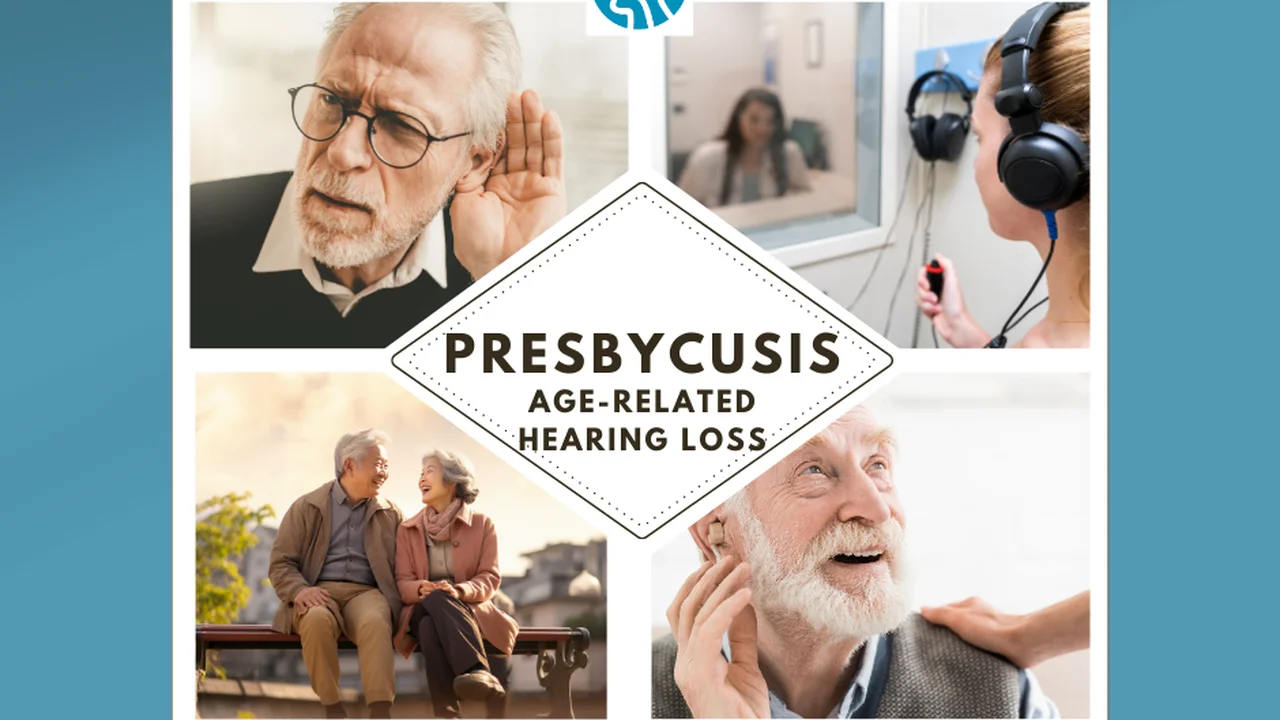Exercising With Hearing Aids Stay Active
Discover how to safely exercise with hearing aids. Learn tips for managing sweat, securing devices, and maintaining an active lifestyle.

Exercising With Hearing Aids Stay Active
Staying active is incredibly important for your overall health and well-being. Regular exercise can boost your mood, improve cardiovascular health, and even sharpen your cognitive functions. For those who rely on hearing aids, the idea of exercising might bring up a few concerns. How do you protect your devices from sweat? Will they stay in place during a vigorous workout? What about water activities? Don't worry, you're not alone in these questions. Many hearing aid users successfully integrate their devices into their active lifestyles with a few smart strategies and the right equipment. This comprehensive guide will walk you through everything you need to know to keep your hearing aids safe and sound while you stay fit.
Understanding the Challenges of Exercising with Hearing Aids
Before diving into solutions, it's helpful to understand the main challenges. The primary culprits are moisture, impact, and displacement. Sweat, rain, or even high humidity can damage the delicate electronics inside your hearing aids. Physical activity often involves movement and potential bumps, which can dislodge or even break your devices. And let's not forget the risk of losing a hearing aid during a particularly intense session. Addressing these concerns proactively will ensure your hearing aids last longer and perform better.
Protecting Hearing Aids from Sweat and Moisture During Workouts
Moisture is the number one enemy of hearing aids. Sweat, in particular, is corrosive and can lead to malfunctions. Here's how to combat it:
Sweat Protection for Hearing Aids Essential Accessories
- Hearing Aid Sleeves and Covers: These are often made from moisture-wicking materials like spandex or nylon. They fit snugly over your hearing aids, creating a barrier against sweat. Brands like Ear Gear and Hearing Aid Sweat Bands offer a variety of sizes and colors for different hearing aid styles (BTE, RIC, ITE). They are relatively inexpensive and can significantly extend the life of your devices. For example, a pair of Ear Gear Mini BTE covers might cost around $20-$30.
- Headbands and Sweatbands: A simple athletic headband can absorb sweat before it reaches your ears and hearing aids. Look for moisture-wicking fabrics. These are great for all types of hearing aids, especially if you're concerned about sweat dripping down from your forehead.
- Wipe Down Regularly: Carry a soft, dry cloth with you and gently wipe down your hearing aids during and after your workout. This removes surface moisture before it can seep in.
Drying and Storage Solutions for Hearing Aids After Exercise
- Hearing Aid Dryers and Dehumidifiers: These are crucial for removing any moisture that might have gotten into your devices.
- Electronic Dryers: Devices like the Dry & Store Global II or the PerfectDry Lux use gentle heat and/or UV light to dry and sanitize hearing aids. They are an investment (typically $50-$150) but are highly effective. The PerfectDry Lux, for instance, completes a drying cycle in about 30-45 minutes.
- Desiccant Dry Jars: These are simpler, more affordable options (around $10-$20). They contain desiccant pellets that absorb moisture. You place your hearing aids in the jar overnight. Brands like Hal-Hen Super Dri-Aid are popular. Remember to replace the desiccant regularly as it loses effectiveness.
- Avoid Air Drying in Humid Environments: Don't just leave your hearing aids out on a counter in a humid bathroom. Always use a dedicated drying solution.
Securing Hearing Aids During Physical Activity Preventing Loss
Losing a hearing aid during exercise can be a nightmare. Here's how to keep them securely in place:
Retention Options for Hearing Aids During Sports
- Hearing Aid Clips and Cords: These attach to your hearing aids and then clip to your clothing, preventing them from falling to the ground if dislodged. They are particularly useful for children but can be beneficial for adults too, especially during high-impact activities. Brands like Ear Gear also offer retention cords integrated with their covers.
- Proper Fit: Ensure your hearing aids, especially custom-molded ITE/ITC/CIC devices or BTE earmolds, fit snugly. If they feel loose, consult your audiologist for adjustments or new molds. A well-fitting device is less likely to fall out.
- Sport Locks and Retention Wires: Many BTE and RIC hearing aids come with small, flexible wires or 'sport locks' that tuck into the concha of your ear, providing extra stability. Make sure these are properly adjusted.
Best Hearing Aid Styles for Active Lifestyles Product Recommendations
While all hearing aid styles can be worn during exercise with proper precautions, some are inherently more secure or durable:
- Behind-The-Ear (BTE) and Receiver-In-Canal (RIC) with Sport Locks: These are generally a good choice. The main body sits behind the ear, and with a well-fitted earmold or dome and a sport lock, they are quite secure. Many modern BTE/RIC devices also come with higher IP ratings for water and dust resistance.
- In-The-Ear (ITE) and In-The-Canal (ITC) Custom Molds: Because these are custom-made to fit your ear canal, they offer excellent retention. However, they are more susceptible to sweat directly entering the device.
- Completely-In-Canal (CIC) and Invisible-In-Canal (IIC): While very discreet, their small size can make them harder to handle with sweaty hands and potentially easier to lose if dislodged. They also offer less protection against moisture due to their direct placement in the ear canal.
Specific Exercise Types and Hearing Aid Considerations
Different activities pose different challenges. Here's how to approach common exercise types:
Running and Jogging With Hearing Aids
For running, sweat is the main concern. Use sweatbands or hearing aid covers. Ensure your devices are snug to prevent bouncing. Many modern hearing aids have motion sensors that can adjust settings for running, optimizing sound quality and reducing wind noise. Consider models with high IP ratings for water and dust resistance.
Cycling and Biking With Hearing Aids
Wind noise can be a significant issue for cyclists. Look for hearing aids with advanced wind noise reduction features. Some hearing aids, like the Phonak Audeo Lumity or Oticon More, excel in this area. If wearing a helmet, ensure it doesn't dislodge your hearing aids. Consider BTE or RIC styles that sit comfortably behind the ear without interference.
Gym Workouts and Weightlifting With Hearing Aids
Sweat and potential impact are key. Use sweat covers. If you're lifting weights, be mindful of any equipment that might brush against your ears. Bluetooth connectivity is a huge plus here, allowing you to stream music or podcasts directly to your hearing aids without needing headphones that might interfere with the devices.
Water Sports and Swimming With Hearing Aids
This is where caution is paramount. Most hearing aids are water-resistant, not waterproof. This means they can withstand splashes or light rain, but not submersion. For swimming or heavy water sports, it's generally recommended to remove your hearing aids. If you absolutely need hearing assistance in the water, consider specialized waterproof hearing aids or accessories:
- Waterproof Hearing Aids: Some manufacturers offer truly waterproof models, often designed for children or very active adults. For example, the Phonak Audéo Life is designed to be fully submersible in fresh, salt, or chlorinated water up to 50 cm. It's a RIC style and offers excellent sound quality. Expect to pay a premium for these, often in the $3000-$7000 per aid range, depending on technology level.
- Waterproof Cases/Sleeves: These are less common for full submersion but can offer extra protection for water-resistant devices in very wet conditions.
- Bone Conduction Headphones: If you remove your hearing aids for swimming, bone conduction headphones (like those from Shokz OpenSwim) can provide an alternative way to listen to music or audio in the water, though they don't amplify environmental sounds.
Yoga and Pilates With Hearing Aids
These activities are generally low impact, but sweat can still be an issue. Headbands or sweat covers are recommended. Ensure your hearing aids are comfortable during various poses, especially those that involve lying on your side or back. The flexibility of RIC or BTE devices often makes them a good choice here.
Recommended Hearing Aids for Active Individuals Product Comparisons
When choosing hearing aids for an active lifestyle, look for durability, water resistance, and features that enhance listening in dynamic environments. Here are a few top contenders:
Top Hearing Aid Models for Active Lifestyles
- Phonak Audéo Lumity (RIC):
- Key Features: Excellent speech understanding in noise, advanced motion sensor hearing, universal Bluetooth connectivity, rechargeable options, high IP68 rating (dust and water resistant). The Lumity Life variant is fully waterproof.
- Use Case: Ideal for almost any activity, from hiking to gym workouts. The Lumity Life is perfect for swimming or heavy sweating.
- Price Range: $2,500 - $7,000 per aid, depending on technology level and provider. The Lumity Life tends to be at the higher end.
- Comparison: Known for its robust build and superior performance in challenging listening environments, making it a favorite among active users.
- Oticon More (RIC):
- Key Features: Deep Neural Network (DNN) technology for a more natural soundscape, rechargeable, direct streaming from iOS and Android, good wind noise management, IP68 rating.
- Use Case: Great for outdoor activities where natural sound awareness is important, like cycling or walking.
- Price Range: $2,000 - $6,500 per aid.
- Comparison: Offers a unique approach to sound processing, providing a fuller sound environment which can be beneficial for situational awareness during exercise.
- Starkey Genesis AI (RIC/Custom):
- Key Features: AI-powered sound processing, health tracking (steps, engagement), fall detection, rechargeable, high IP rating. Available in both RIC and custom ITE/ITC styles.
- Use Case: Excellent for those who want integrated health monitoring with their hearing aids. The custom styles offer great retention for gym work.
- Price Range: $2,800 - $7,500 per aid.
- Comparison: Stands out with its health-tracking capabilities, making it a 'smart' hearing aid for the health-conscious individual.
- Resound Omnia (RIC/BTE):
- Key Features: Focus on 'hear in noise' technology, M&RIE (Microphone & Receiver-In-Ear) option for natural sound, rechargeable, direct streaming, IP68 rating.
- Use Case: Particularly strong in noisy gym environments or group sports where speech clarity is crucial.
- Price Range: $2,200 - $6,800 per aid.
- Comparison: Renowned for its ability to help users hear speech better in complex soundscapes, which is a huge advantage during active social situations.
General Tips for Exercising with Hearing Aids
Maintenance and Care for Active Hearing Aid Users
- Daily Cleaning: Even with protection, always clean your hearing aids thoroughly after exercise. Use a soft, dry cloth and any cleaning tools provided by your audiologist.
- Use a Drying Kit: Make it a habit to place your hearing aids in a drying kit or dehumidifier every night, especially after a sweaty workout.
- Regular Audiologist Check-ups: Your audiologist can check for moisture damage, clean your devices professionally, and ensure your fit is still optimal.
Comfort and Performance Considerations for Hearing Aids
- Trial Period: If you're getting new hearing aids, discuss your active lifestyle with your audiologist and take advantage of the trial period to test them during your typical workouts.
- Program Settings: Ask your audiologist about specific program settings for noisy environments, wind noise reduction, or even a 'sport' program if available.
- Battery Life: Streaming music or using advanced features during exercise can drain batteries faster. Always carry spare batteries for disposable models or ensure your rechargeable devices are fully charged.
Addressing Common Concerns About Hearing Aids and Exercise
Can I Wear Headphones Over My Hearing Aids While Exercising
It depends on the type of headphones and hearing aids. Over-ear headphones can often be worn comfortably over BTE or RIC hearing aids, but they might press against the devices, causing feedback or discomfort. In-ear headphones or earbuds are generally not compatible with most hearing aids. Many modern hearing aids offer direct streaming via Bluetooth, eliminating the need for separate headphones altogether. This is often the best solution for listening to music or podcasts during exercise.
What About Sports That Involve Headgear or Helmets
If your sport requires a helmet (e.g., cycling, skiing, contact sports), ensure your hearing aids fit comfortably underneath without being dislodged or causing pressure points. BTE and RIC styles are usually more adaptable than larger ITE devices. Always check for proper fit before engaging in the activity. If there's a risk of impact, consider removing your hearing aids or using specialized protective gear.
Dealing with Feedback During Exercise
Movement, sweat, and even changes in ear canal shape during exercise can sometimes cause feedback (whistling). Ensure your hearing aids are properly seated and that your earmolds/domes fit well. Sweat covers can also help by preventing moisture from interfering with the microphone. If feedback persists, consult your audiologist for adjustments.
Don't let hearing loss hold you back from an active and healthy lifestyle. With the right hearing aids, accessories, and care routine, you can enjoy all your favorite physical activities while still experiencing the world around you with clear, amplified sound. Talk to your audiologist about your specific needs and they can help you find the perfect solution to keep you moving and hearing well.
:max_bytes(150000):strip_icc()/277019-baked-pork-chops-with-cream-of-mushroom-soup-DDMFS-beauty-4x3-BG-7505-5762b731cf30447d9cbbbbbf387beafa.jpg)






